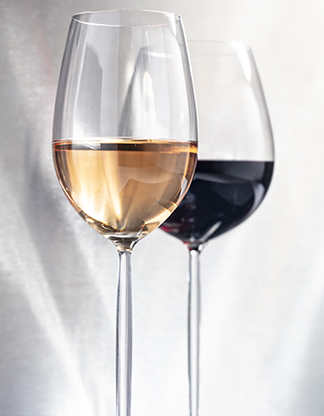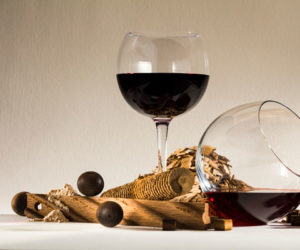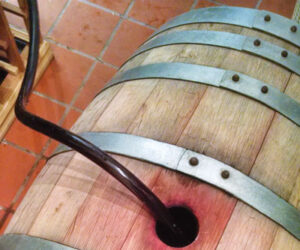
Most of us have either seen the word on a label or heard of the process saignée (“sohn-yay”), the French term meaning “to bleed.” The origin of this process is unclear, but as it is a French term that has been referenced in red Bordeauxs and red Burgundies we can assume it originated somewhere in France long ago. Like many French terms, knowing the definition does not really help the winemaker decide how, when, or why they should use the technique; posing the question, “to bleed or not too bleed?”
The saignée technique is another tool in the winemaker’s toolbox. To use a tool, we need to understand the dynamics of the process and the chemistry behind its use. Winemakers that arm themselves with various tools put themselves in a position to make the highest quality wine consistently with different grape varieties from their winegrowing region, vintage after vintage.
Saignée, or what is also referred to as pre-fermentation juice runoff, is simply the removal of a portion of juice from a tank of crushed red grapes. Saignée certainly sounds more mysterious or romantic, but don’t you think most things sound more romantic in French? The saignée method can serve two purposes; it is used to produce a rosé wine (from the juice that is run off) and it concentrates the remaining juice that is left behind, which is then made into a red wine. As I researched saignée, I found quite a bit of discussion reminding me of the chicken and the egg argument, and what came first. Or in this case, is saignée used to make a rosé with darker color and more depth or is rosé just a byproduct of red winemaking and not considered a true rosé?
Why should a winemaker use saignée and when should the juice be removed? We need a bit more detail or specifics to help winemakers new to saignée to decide if this would be beneficial to them. My goal with this article is to help you explore if saignée is right for the wines you are making and to shed some light on the dynamics of saignée that I learned as a winemaker through trial and error.
Performing Saignée
After destemming and crushing red grapes into a tank, the must is then allowed to sit for a period of hours or days. At this point a percentage of the total volume of juice is bled or drained off into another tank for a separate fermentation often made into a rosé-style wine. The removal of the juice results in an increased skin-to-juice ratio of the remaining must, much like the ideal smaller berry size on a cluster of grapes. By increasing the skin-to-juice ratio, in theory, this should produce richer wines with a greater concentration of anthocyanins and tannins. Various studies over the years have shown that both color and phenolics are increased when saignée is employed (Singleton 1972, Gawel et al. 2001, Gerbaux 1993).
Let’s explore in more detail the relationship between anthocyanins and tannins and why concentration of these compounds might be important for certain grape varieties or styles of wine. We’re going to need to dive into a bit of chemistry for this part, but I will keep it broad.
Phenolics or polyphenols are chemical compounds that affect the taste, feel, and color of wine. Most of these phenolics are derived from the pulp, skin, seeds, and stems of the grapes. Phenolics can be classified into two groups — flavonoids and non-flavonoids. For this article we will be focusing on the flavonoids, which include the anthocyanins and tannins that contribute to the color and mouthfeel of the wine and work in combination to stabilize that color.
Extraction of anthocyanin peaks in the first 3–4 days and then declines slightly during the remainder of the fermentation. Extraction of other flavonoids, flavor, and tannins continue to increase in concentration with contact time, to a point. This extraction rate of tannins can be increased with higher fermentation temperatures, the presence of alcohol, and/or mechanical movement of the must. Anthocyanins and tannins are involved in the formation of complexes that help to keep both the anthocyanins and tannins in solution. This process is important in retaining and stabilizing the color forming pigment-tannin complexes that keep them in solution. Different grape varieties or cultivars have different levels of both anthocyanins and tannins, which is why we see differences in the final color of the wine. Think of the color differences between a Pinot Noir and Cabernet Sauvignon, even the darkest Pinot Noir is nowhere close to the deep opaque color of Cabernet Sauvignon.
Working within the grape’s individual levels of anthocyanins and tannins, color stabilization is important to maintain the color in the wine. If the anthocyanins don’t form the pigment-tannin complexes, then anthocyanins will bind to something else. This can be solids in the newly fermented wine, proteins, or maybe yeast; either way the results are the same, color starts to precipitate out after fermentation. When we compare vinifera to hybrids we can see a much deeper color initially with hybrids, due to more color pigments in the outer layers of the grape skin. However, vinifera grapes have higher levels of tannins or less protein that binds to the tannin than hybrids. As a result, we see a darker shade with hybrids initially, then the color lightens at the end of fermentation due to less tannin-pigment complexes being formed, lower tannin levels, and higher amounts of protein that bind up the tannins. In the past 10 years there has been much more research and new products on the market to address the individual issues that come with working with hybrids and increasing the pigment-tannin complexes for color stabilization.
Due to the large influence of phenolic compounds on red wine quality, many winemaking techniques have been developed to influence the extraction of these compounds during vinification. These include: Cold soak maceration, dry ice maceration, pectolytic enzymes, saignée, delestage, pumpovers/punchdowns, and extended maceration. Winemakers can use these methods individually or in combination to increase the phenolic extraction of both color and tannin. To choose, they must consider the pros and cons of each and decide what might work best for the style of wine they are making and address deficiencies seen in their grapes.
There are variables to identify and experiment with when using the saignée technique, including the amount of time the juice is in contact with skins/seeds and what percentage of juice to bleed or drain. Typically, juice removal amounts are in the range of 10 to 20 percent of the total volume of juice, but this is an average. There is not a lot of research on a more precise percent of juice removed due to grape variety, climate, and wine region variations. Remember that your total volume of must is not the liquid volume; liquid volume can vary depending on cultivar, berry size and if water amelioration was used, but on average it is in the 70–85% range of must volume.
Deciding when to bleed or drain can be anywhere from a couple hours to a few days depending on the parameters you want in the portion of juice to be removed and fermented separately as a rosé wine. It has been my experience that the timing of juice removal is based more on actual dynamics and individual winery equipment and setup. Typically, saignée is performed pre-fermentation when the must is still one homogenous mass with no separation of skins from the liquid like we see during fermentation when the skins form a cap. It is at this stage small-scale winemakers have an advantage. It is easier to separate juice from must — it might take some time, but it is physically possible to use a mesh bag or a strainer for separation. This becomes a much harder project with 10–20 tons of grapes in a tank that only has a 3-inch racking ball valve for the homogenous mass to flow out, directly hitting a screen that is on top of a collection cart. Invariably, skins/seeds plug the valve, stopping the flow out of the tank if saignée is performed too early. I will leave it to your imagination to figure out how to get it flowing again but will add, more cleaning is always involved. The earlier juice removal is attempted with a homogenous mass of juice, skins, and seeds, the harder it will be to separate liquid from solids. Which translates to multiple screen cleanings to remove skins and seeds, then shoveling into buckets and walking up the ladder to be dumped back into the top of tank.
Like most winemaking techniques, there are pros and cons to each and not all work for the style of wine we are making. Let’s explore some of these pros and cons so you can make a better decision when experimenting with saignée.
Considerations Before You Saignée
There are a number of considerations if doing saignée for the purpose of making a rosé. The first being the differences between production of a straightforward rosé and a saignée rosé. When I set out to make a rosé, I typically pick red grapes very early in the ripening process. I pick early so that I have low Brix, equating to a lower final alcohol, malic acid retention, and higher total acidity. If we are making a rosé from saignée, red grapes have much more hang time to reach phenolic maturity as color and tannins are much more important to quality. As a result, the rosé has a higher Brix and a lower overall total acidity with tartaric acid dominating.
Another potential difference with your saignée rosé would be if you were only able to separate juice from must by starting fermentation. I prefer to use different yeast for my rosé and individual red grape varieties. Starting fermentation prior to juice removal might help with juice removal, but it also forces you to use the same yeast for all your ferments.
Here in Colorado, grapes are grown in a high-desert climate, 4,200–7,000 feet (1,280–2,130 m) above sea level with summer temperatures in the range of 88–105 °F (31–41 °C) May through August. As a result, we see a delay in phenolic maturity, color development, and seed ripening while Brix continues to climb. Water amelioration is used to bring the Brix down so that the alcohol percentage better aligns for both a successful fermentation to dryness and a balanced wine. This water addition has a dilution effect, basing your juice removal percentage by the same percentage of water that was added initially, can lessen this dilution effect. Always add chlorine-free water and make sure to get a good mix on the must; you want it to be a homogenous mixture and water tends to settle on top due to its lower density.
Another thing to keep in mind with saignée is the amount of time this will take prior to starting your fermentation. A couple hours is not a big deal, but 2–3 days is another issue — make sure you are adding sulfur dioxide or another product to protect the wine from wild microbes building up in the population producing unwanted off-odors or volatile acidity. Keeping the temperature low will help slow this down, and make sure you are protecting the must from oxygen by using inert gas on the headspace.
Another question might be what effect juice removal will have on your yeast assimilable nitrogen (YAN) levels with both fermentations. These things are not good or bad, they are simply things for you to consider and think through when experimenting with any new technique.
Perhaps a con to using saignée and its concentration effect with red must, might be if the grapes do not fully ripen prior to picking. In Colorado we have had several early fall frosts in the past 10 years. In those years certain late-ripening varieties did not reach full phenolic maturity. At this point we may not want to concentrate the tannins, causing even more bitterness and/or green components in the wine.
If you decide to use the saignée technique on a few of your grape varieties, remember that grapes ripen at different times, so juice removal will be performed at different times throughout harvest. Processing it at different times can make it difficult to manage the individual lots of juice removed. You could add small amounts of rosé juice to a fermentation vessel spread out over weeks, making it hard to ferment and work with or test. Or moving the rosé ferment to a larger vessel every time you need to add juice from another lot. Another option would be to keep the juice at an extremely low temperature, or even freezing it, to prevent fermentation until you have all the individual batches.
What I found worked best for me was to have a batch of early-pick rosé that slowly started fermentation in a larger tank that I could then add each of the bled off juice portions to as the grape varieties came into the winery. This may or may not work for you or be what you want in the final wine product. The main thing is to think it through and plan prior to starting harvest, so you know what to expect and are prepared.
As a home winemaker, the financial cost of making wine may not be on the top of your priority list, but for a commercial winery it is on their list and an important part of being a successful business. In my research on saignée, I found that initially juice that was bled or drained off was discarded. How long did it take winemakers to discover they could make a product from removed juice? Creating a rosé from the juice that is removed vs. discarding gives you a product that you can enjoy while you’re finishing up your red wine. Saignée rosé has a darker color and possesses more character, showing more terroir. You can even age in neutral oak barrels to give it complexity and longevity. While you’re gaining another product, you’re also cutting your overall volume of red wine produced. This might be what is needed to make a higher quality wine, or it might be to the detriment of your cellar supply if you are making small volumes to begin with. So, as I stated at the beginning of this article, the decision is yours: To saignée or not to saignée.
Winemaking has exponential variables due to climate, cultivars, fermentation, yeast, vessel size and shape, etc.; it is these same variables that make wine such a beautiful, intriguing product. Wine is the culmination of years of experimenting and bringing a balance through both art and science. In my experience winemakers aren’t seeking perfection but do have a deep desire to increase the quality of their wine with each vintage. This can be achieved by investigating the multitude of winemaking techniques, addressing the pros and cons, then translating that into a plan for the next harvest.
Happy experimenting, and don’t forget to take notes!







